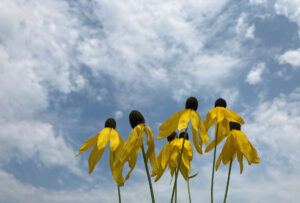Leaving dormant vegetation in place over the winter provides an abundance of benefits, including: food for wildlife, habitat for native bees, and protection from drifting snow just to name a few! Starting off the spring with an early mowing or prescribed burning can also provide benefits for years to come.
Mowing of dormant vegetation can help improve the overall health of a native planting area and get a jump start on the growing season ahead. We recommend the use of a flail mower to mulch the vegetation well. This maintenance will help more spring sunlight reach the soil layer and invigorate native plant growth to get a jump on the growing season, leading to earlier blooms (earlier food source for overwintering pollinators!). Over time, restoration areas that don\’t receive this type of maintenance tend to shift to more grassy systems with less diversity of wildflowers. Remember to leave pockets, or refuges, for local pollinators and nesting birds.
Spring burning can arguably provide the greatest benefit to native plant systems. This management tool helps kill off weedy invasive tree seedlings, enrich soils, remove the built up layers of dormant vegetation, and even naturally creates a mosaic of unburned pockets for local wildlife refuge. Thanks to the blackened surface after a burn, the warmed soil promotes early germination of native plants. After a burn, you may see species of flowering native plants that you hadn\’t seen for years prior. You may also see a decrease in weedy vegetation, especially invasive cool season grasses.
MNL is still taking spring mowing and burning appointments – spots fill up quickly! Call to learn more (763) 295-0010
Call today and set up an appointment with MNL\’s ecologist for a consultation or a management plan to improve the long term success of your project! (763) 295-0010

